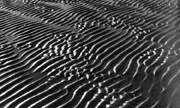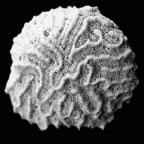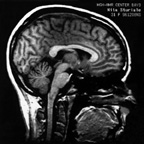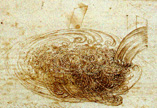 South Beach, Martha's Vineyard, Massachusetts.>>>>>>>
South Beach, Martha's Vineyard, Massachusetts.>>>>>>>
The patterns that waves create after washing on a sandy beach have been used as a metaphor to understand the way experience creates memories in the brain. What insights into consciousness can be revealed by exploring this metaphor further? We are observing the physical traces of mental acivity by creating interactions between thoughts ,water and sand. Our talk at the conference echoed the method of our collaboration. Sturiale outlined the conceptual framework, while de Waard provided the details needed to fulfill the original idea. The following paper describes our presentation and reflects the style of the talk. Each section covers different facets of the project and is presented by a different speaker(indicated in parenthesis).
keywords: brain, art, science, waves, eeg, nature, form, thought, interdisciplinary
(de Waard) This talk is structured to reflect how we have worked together on the project. We will each present different aspects of the work. Nita will describe some of the conceptual aspects - the inspirations and metaphors that have driven her work preceding this collaboration. I will describe the physics of the experiment as well as my perspective (as a scientist) on the role artistic thinking has in science.
(Sturiale) I am a visual artist with a deeply-felt hunger for finding answers to my questions about nature and the human brain. I am particularly fascinated by the processes of growth and motion and believe that art-works and science-works are both expressions of the same fundamental process of natural evolution and creation. I try to use my art-works as tools for education. Using the information and insights of the sciences as the medium for my work, I hope to encourage both students and viewers to think about their curiosities and express their questions and understandings.
(de Waard) I am trained as a physicist and have worked in science publishing and science education. I am interested in spreading the virus of scientific thought: I preach the question. To me, practicing science is wholeheartedly embracing the questions of your childhood. It is constantly adjusting your ideas by your perception of reality. Science is about sharpening, expanding and if needed, quantifying these perceptions - in the full realization that answering any true question leads to the uncovering of several more urgent and more fundamental questions.
(Sturiale) As we are both educators, we became interested in how our collaboration might illuminate those subjects that we are most intrigued by. We found that our friendship and different viewpoints have fostered rich conversations BECAUSE of our differences. We have learned much from each other and view our collaboration as an experiment combining art and science as an TOOL for understanding ourselves and nature and educating those that might experience our work.
(Sturiale) I spent several summers living a very near a beach on the Atlantic ocean and fell off to sleep with the rhythms of ocean waves. This experience permeated my dreams and time awake. I felt a symbiosis with nature. It was an intense place to be.
 South Beach, Martha's Vineyard, Massachusetts.>>>>>>>
South Beach, Martha's Vineyard, Massachusetts.>>>>>>>
Around the same time I was also studying tidal rhythms, time measurement and the physics of wave behavior. The edge of the sea became very interesting to me and became a metaphor for the boundary between me (my thoughts) and my experience. At this time, I learned to appreciate a dynamic interaction between my intellectual and perceptual life. The rhythms and patterns that emerge at this kind of boundary are similar to those found in nature.
More specifically, we are looking at the patterns that are created in sand by water motion and behave as a record for the interaction between the land and the sea. The energy created by the rotating earth and the atmospheric forces that shape the winds of the planet are transduced from one form to another. Much like the kind of transduction that occurs from our experience to our senses to neuronal firings and then to the sensation of a whole idea or question.
 <<<<<< Sand patterns.
<<<<<< Sand patterns.Our question was - how can we create a record of our thoughts using nature as the model? How can we capture brain activity and transduce it into a form in nature?
A quote from the sociobiologist, Edward O. Wilson (1978) - "To classify consciousness as the action of organic machinery is in no way to underestimate its power. In Sir Charles Sherrington’s splendid metaphor, the brain is an "enchanted loom where millions of flashing shuttles weave a dissolving pattern”. Since the mind recreates reality from the abstractions of sense impressions, it can equally well simulate reality by recall and fantasy. The brain invents stories and runs imagined and remembered events back and forth through time.”
(de Waard) Our model includes an apparatus that uses brain waves, in the form of EEG(electroencephalograph) data, to move water - this movement, in turn, influences the formation of sand patterns.
The EEG is recorded from electrodes placed at a single left frontal lobe and a single right frontal lobe site of a participant. These electrodes register electrical brain activity (to the extent that it can be measured at the scalp) and output a jittery line of varying voltage: the EEG trace. This voltage, which varies with brain activity (sleep produces long slow pattern, epileptic seizures show the seismic traces of a neural earthquake), is then fed into the leads of a small motor. Information from these two sites is averaged onto a single channel. The EEG data is transmitted and recorded using a computer driven EEG analysis system. The patterns of a subject's EEG signal are then amplified and determine the action of the motor driving a paddle on one end of a rectangular vessel of water with a sloping, sandy 'beach'.
 <<<<<<< The EEG of a participant.
<<<<<<< The EEG of a participant.
(Sturiale) My fascination with the physical expression of natural motion and waves, the kind that exists at the edge of the sea, and with the structure of thought, drove me to find physical evidence for the similarities between these processes.
 <<<<<<< Brain coral.
<<<<<<< Brain coral.
I wondered if the similarity between the way brain coral looks and the structure
of the brain was anything more than superficial. Upon inquiry, I learned that
it was much more thanthat. The way in which coral grows (tiny individual organisms,
living in colonies and excreting calcium carbonate dependent on environmental
conditions) was IN FACT much like the way the brain grows. The shape and structure
is an emergent quality. During neurodevelopment, the shaping and synaptic generation
reflect the organism's experience. Coral is a physical expression of the nature
of the organisms experience - as are thoughts, ideas, and memories.
 Magnetic
Resonance Image of Sturiale's brain.>>>>>>
Magnetic
Resonance Image of Sturiale's brain.>>>>>>
If I asked you to shape clay as you thought, would your thoughts be somehow expressed in the clay? This is metaphorical question, of course, but I think it is useful to think of our thoughts as physical entities in the world that exist in place along with all other things and change according to the processes of evolution. The processes of growth, evolution and wave behavior guide the fabrication of coral, sand patterns on the surf, and ideas.
(de Waard) The patterns on the beach inside the wave tank of our model change according to the brain signals and the moving water. In this way, brain activity creates a physical pattern in the sand, providing a new and playful way to look at brain wave patterns and the experience of thought.
So - brain activity > voltage > motor changes > paddle > water waves > sand patterns. In the end, thoughts are registered like sand ripples on a beach. It is a familiar metaphor from consciousness studies; thoughts are compared to ripples on a sandy beach (Calvin, 1989). In this metaphor, the beach is the plastic brain and the sea is the pounding that experience makes on the drum of our senses. The ripples, then, are what reality leaves behind in our brain. Sand patterns become the Traces of Thought.
(Sturiale) While in London, I had the opportunity to visit the Natural History Museum there and found myself in a room with an impressive piece of sandstone. It was shaped by the tidal motion of water upon it 200 millions years ago. I couldn't help thinking of it as an ANCIENT THOUGHT.
 Leonardo da Vinci's thoughts on water from the 15th century
>>>>>>
Leonardo da Vinci's thoughts on water from the 15th century
>>>>>>
(Sturiale) The perhaps over-used example of Leonardo da Vinci still works as a model for balancing art and science. The historian, Pedretti (1997) wrote that, for Leonardo, painting was, “a form of knowledge in the first order.” His art drove his science and his science enhanced his art. Another historian, Letze (1997) wrote, “His artworks were not only an attempt to reflect reality but also a search for the laws of nature, science and proportion to be handed down to prosperity.”
We think of this project as itself also existing at the boundary between art and science. The Traces of Thought are recorded and available for review after the time they were created. It is an effort to create something new while also measuring and quantifying the electrical activity of the brain and its thoughts. We suggest that new ways for studying a subject like consciousness need to look at patterns in nature for clues.
Both science and art have been suffering from over-specialization and obscurity (mistaken for profundity) - this results in stagnation and an inability to jump out of existing forms in order to try something new or apparently simple. Science can learn from art and revisit the importance of originality and creativity in solving problems and observing the details of nature. Neither science nor art will progress far without changing ideas and research directions. This can only happen by better communication between disciplines.
Lawrence and Locke's article in Nature (1997) speaks to this problem with reference to scientific research. They believe, “...our writing has degenerated into an impersonal coded newspeak that leaves the authors’ characters undetectable, their ideas disguised. Any point at which there emerges something resembling a truly personal or literary style in a technical article is commonly considered a point in failure.” A similar situation exists in the art world - anything resembling scientific fact is considered uncreative or antithetical to the artistic process. Our view is that these preconceptions are dangerously short-sighted and problematic to both the power of art and scientific study. Lawrence and Locke (1997) again, “Scientists, who like artists should be trying to build pictures of ideas.” And, artists, like scientists, should be including shared understandings of the natural world in their pictures and ideas.
(de Waard) At the Meeting in Tucson 'Towards A Science of Consciousness' which several people at CAiiA have referred to, two types of people prevailed: scientists and people with a moral or religious agenda. The scientists stuck to themselves. Their lectures contained much jargon and focused on reaching other scientists and convincing them of the validity of their experiments or theories. The people with mythical, religious or moral agendas (I recall a Tarot card reader, a born-again Christian and several different New Age groups) focused on reaching other people and convincing them of their convictions.
I missed artists there - artists concerned with our current findings in consciousness studies and with integrating these views with what it is like to be human - aware and conscious. I think art can help science to integrate the isolated, jargon-filled, specialist findings from different disciplines into one coherent whole. Art can help us cope with the abundance of facts we are collecting about our own thinking. Science can help and inspire artists by providing provocative and non-intuitive information about the way our brains work. Science can also provide art with new and exciting images - MRI and PET scans, as well as other images that are produced by sense-enhancing instruments (telescopes, microscopes, computer simulation). (As a side note: it is interesting that the Virtual Reality techniques which are used widely as an artform at this conference were developed by the military for training -it is quite powerful that, instead of destroying other humans, this tool is used as an exploration of what it is like to be human...)
And lastly, the collaboration between art and science is vital because artists have something that scientists desperately lack: artists are very cool. For me, as a scientist, it is great to be at a meeting where the coolest people are interested in what us nerds have produced. Maybe we can make a prolific swap: if scientists lend artists some of their images and information then artists can give scientists some of their cool...
(Sturiale) In addition to coolness, I think that artists also possess the freedom to combine information in new and enlightening ways. How many times have we heard stories of brilliant scientists coming to a new theory in a dream or in the shower. This is when their minds are relaxed and expansive; like that of an artist. But artists do not have easy access to scientific information in contemporary culture. This situation will change. More collaborations between artists and scientists and more individuals who are driven by thinking both artistically and scientifically will emerge. There are exciting possibililties where these worlds meet.
We are suggesting that there is a wave-like relationship between thinking artistically and thinking scientifically. A balance can be found between finding solutions, creating new ideas and constructing metaphors that help us understand ourselves. There is a history of images that reveal the state of understanding of the brain. The next images, models and metaphors of consciousness will reflect the natural patterns we see around us and the interdisciplinary nature of nature itself.
Moholy-Nagy eloquently describes the problem of over-specialization - “The problem of our generation is to bring the intellectual and emotional, the social and technological components into balanced play; to learn to see and feel them in relationship. Without this interrelatedness there remains only the disjunctive technical skill of handling human affairs, a rigidity stifling biological and social impulses; a memorized not a lived life.” (Moholy-Nagy, 1947)
Apart from being a physical exploration of consciousness, this presentation also provides an opportunity to discuss the different views artists and scientists have of the relationship between the individual and the natural world. Our collaboration is both an experiment and an artwork. From a scientific view, a person's individuality, expressed by her thoughts, is transcribed in a clinical setting as electronic wave patterns that resemble the wave shapes seen in other natural phenomena. As an artwork, it is the expression of individual thoughts, feelings, and ideas in the material world. A participant's EEG shapes matter according to these thoughts, feelings and ideas, thereby projecting an outside representation of the physical structures from within one's mind.
Science aims to analyze physical phenomena. It uses tools that allow for a detailed and rigorous analysis. By linking EEG data to sand ripples, we are using scientific equipment to establish a situation in which the mind can be studied by looking at waves in the sand. The artistic approach allows the freedom to imagine the possible connection between these phenomena. This approach also works to influence a viewer's perceptions and curiosities about the interrelatedness of thought and nature by making the connection materialize. Our work suggests that a holistic and rich study of nature requires a symbiotic linkage between both an artistic and a scientific approach. Together, a full experiential exploration is possible. Traces of Thought is a collaboration with equal impact from both disciplines and exists as both art and science.
References
Calvin, W. 1989. The Cerebral Symphony. New York, NY: Bantam Books.
Lawrence, P. & Locke, M. 1997. 'A Man for Our Season'. Nature, Vol. 386, 24
April 1997, p. 757-8.
Letze, O., 1997. In Letze, O. & Buchsteiner, T., ed. Leonardo da Vinci: Scientist,
Inventor, Artist. Tubingen, Germany: Institut fur Kulturaustausch, p. 27.
Moholy-Nagy, 1947. Vision in Motion, New York: Paul Theobald. p.12.
Pedretti, C. 1997. In Letze, O. & Buchsteiner, T., ed. Leonardo da Vinci: Scientist,
Inventor, Artist. Tubingen, Germany: Institut fur Kulturaustausch, p. 17.
Wilson, E. O. 1978. On Human Nature. Cambridge, MA: Harvard University Press.
Anita de Waard is trained as a physicist and works in science publishing and science education. She is interested in spreading the virus of scientific thought: to preach the question. Her current job is trying to build bridges between information technology and scientific publishing for Elsevier Science, a large publishing company. While she travels between Holland, New York City and Boston, she remains persistently curious and interested, continuously absorbing information from artists and scientists alike.
Nita Sturiale is an artist and educator living in Somerville, Massachusetts. As a Jacob K. Javits Fellow, she received a Master of Fine Arts degree from the School of the Museum of Fine Arts, Boston and a Master of Education degree from the Harvard Graduate School of Education. She creates artwork based on research into natural phenomena and the complexities of the human brain. She teaches at the Massachusetts College of Art and at the Boston Museum of Science. Her effort is to reveal bridges between art and science and promote inter-disciplinary inquiry of ourselves and our surroundings.